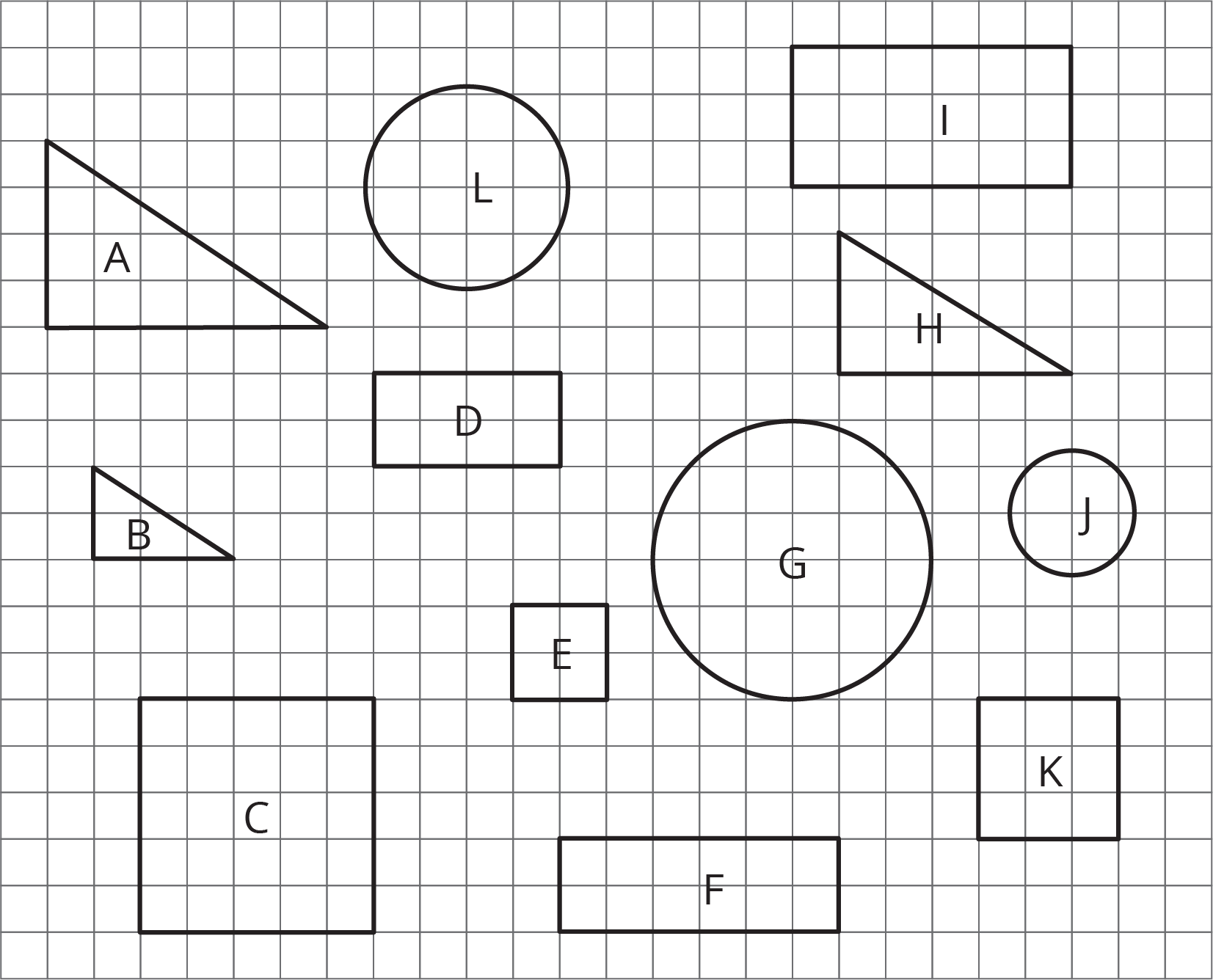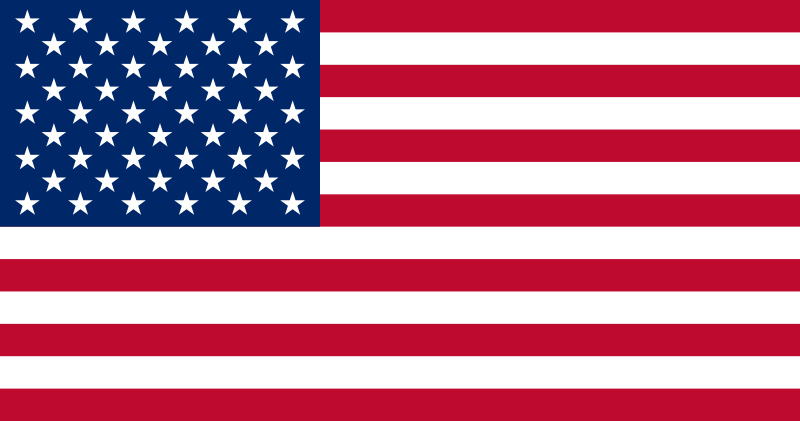Lesson 1
Lots of Flags
1.1: Scaled or Not? (5 minutes)
Warm-up
This warm-up prompts students to reason about proportional relationships in geometric objects as a review of work done earlier in grade 7. As students discuss their answers with their partner, select students to share their answers to the second question during the whole-class discussion. Select students so that different sets of objects and their scale factors are represented in the discussion.
Launch
Arrange students in groups of 2. Give students 1 minute of quiet work time and another 1–2 minutes to share their solutions with their partner. Ask students to make sure they have the same objects identified in the first question. If one partner is missing a set of scaled objects, they should add them to their list during their partner discussion.
Student Facing
- Which of the geometric objects are scaled versions of each other?

- Pick two of the objects that are scaled copies and find the scale factor.
Student Response
For access, consult one of our IM Certified Partners.
Anticipated Misconceptions
Students might think H is a scaled version of A or B. Suggest that they consider possible scale factors to get from, for example, A to H.
Activity Synthesis
Select a couple of students, with a variety of answers to the second question, to share their answers to the second question. Ask students, “Did you encounter any objects that you initially believed were scaled versions of one another? How did you decide that they weren't?”
1.2: Flags Are Many Sizes (15 minutes)
Activity
In this introductory lesson students get a chance to recall what they have previously learned about ratios and proportional relationships. They will build on these ideas in the next few lessons where they will work with ratios and rates involving fractions. In this activity, students can leverage their recent work on creating scale drawings to make connections between the dimensions of a different sized flag and the ratio of the side lengths.
A note about flag dimensions: The official government flag has sides with ratio \(1:1.9\), i.e., the width of the flag is 1.9 times its height. However, many commercially sold flags use different ratios. This activity is working with the official ratio. If there is a flag displayed in the classroom, it would be interesting to check if it uses the official ratio or one of the other common commercial ratios, such as \(2 : 3\) or \(5 : 8\) or \(6 : 10\).
Another interesting note about the flag: The current 50 star version of the flag was designed by a 17 year old HS student as a class project.
Launch
Arrange students in groups of 3–4. If the class room has a display of the flag which can be reached, ask a student to measure the dimensions of the flag.
Tell students, "The United States flag is displayed in many different sizes and for different purposes. One standard size is 19 feet by 10 feet. What would be a possible use for a flag of this size?"
Ask student where else they have seen flags displayed.
Supports accessibility for: Memory; Conceptual processing
Design Principle(s): Cultivate conversation; Support sense-making
Student Facing
One standard size for the United States flag is 19 feet by 10 feet. On a flag of this size, the union (the blue rectangle in the top-left corner) is \(7\frac58\) feet by \(5\frac38\) feet.
There are many places that display flags of different sizes.
- Many classrooms display a U.S. flag.
- Flags are often displayed on stamps.
- There was a flag on the space shuttle.
- Astronauts on the Apollo missions had a flag on a shoulder patch.

-
Choose one of the four options and decide on a size that would be appropriate for this flag. Find the size of the union.
- Share your answer with another group that used a different option. What do your dimensions have in common?
Student Response
For access, consult one of our IM Certified Partners.
Activity Synthesis
Record the groups' measurements in a table to show that there is a constant of proportionality.
1.3: What Percentage Is the Union? (15 minutes)
Activity
This activity continues to look at the U.S. flag by asking questions about percentages, which students studied in grade 6. Later in this unit, students will continue working with percentages, including percent increase and decrease.
Knowing the side lengths of the flag and of the union allows you to compute the area of the flag and of the union. Students can then compute what percentage of the flag is taken up by the union. Finding out what percentage of the flag is red requires additional reasoning. Students can either compute the area of the red stripes or they can see what fraction of the non-union part of the flag is red.
This is a good opportunity for students to estimate their answers and get a visual idea of the size of different percentages.
Launch
Arrange students in groups of 3–4. Tell students that they will continue to examine the United States flag, this time looking at area.
Student Facing
On a U.S. flag that is 19 feet by 10 feet, the union is \(7\frac58\) feet by \(5\frac38\) feet. For each question, first estimate the answer and then compute the actual percentage.
- What percentage of the flag is taken up by the union?
-
What percentage of the flag is red? Be prepared to share your reasoning.
Student Response
For access, consult one of our IM Certified Partners.
Student Facing
Are you ready for more?
The largest U.S. flag in the world is 225 feet by 505 feet.
- Is the ratio of the length to the width equivalent to \(1:1.9\), the ratio for official government flags?
- If a square yard of the flag weighs about 3.8 ounces, how much does the entire flag weigh in pounds?
Student Response
For access, consult one of our IM Certified Partners.
Activity Synthesis
The purpose of this discussion is to emphasize the use of proportion when working with areas of rectangles. Ask students to compare their estimated percentage with their calculated percentage. Ask students such as:
- “Did you use the image of the flag—a rectangle—to guide your estimate?”
- “Did you round the given dimensions to find the estimated percentage?”
Supports accessibility for: Language; Social-emotional skills
Design Principle(s): Support sense-making, Optimize output (for comparison)
Lesson Synthesis
Lesson Synthesis
In this lesson, we used what we know about scale factors and dimensions of rectangles to answer questions related to the United States flag. Consider asking some of the following questions:
- “How can you tell whether two objects are scaled versions of one another?”
- “What properties stay the same when an object is scaled up or down?”
- “What strategies did you use to find properties of a scaled object, e.g. the dimensions of the union on a small flag?”
- “How did you go about finding the estimated percentage of total area on the United States flag (taken up by the union or the red region)?”
1.4: Cool-down - Colorado State Flag (5 minutes)
Cool-Down
For access, consult one of our IM Certified Partners.
Student Lesson Summary
Student Facing
Imagine you have a painting that is 15 feet wide and 5 feet high. To sketch a scaled copy of the painting, the ratio of the width and height of a scaled copy must be equivalent to \(15:5\). What is the height of a scaled copy that is 2 feet across?
| width | height |
|---|---|
| 15 | 5 |
| 2 | \(h\) |
We know that the height is \(\frac13\) the width, so \(h=\frac13 \boldcdot 2\) or \(\frac23\).
Sometimes ratios include fractions and decimals. We will be working with these kinds of ratios in the next few lessons.